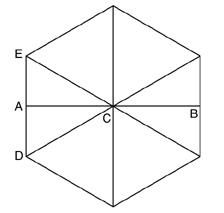Number of Cells to the Square Inch
Number of Cells to the Square Inch
December, 1887 – Bee Culture
It is common to speak of combs as containing 25 worker-cells to the square inch, and 16 drone-cells. Ought we to speak so loosely? My attention was first called to it in Frank Cheshire’s book, where he gives 28-13/16 as the number of worker-cells to the square inch, and 18-178/375 drone-cells. If the cells were square, 25 and 16 would be correct; but they are hexagons.
Any one curious in the matter can easily solve it by algebra, or even by arithmetic. In the figure of a hexagon here given, having the diameter AB we have 6 equal equilateral triangles. Bisecting one of them gives us the right-angled triangle ACD, with the hypothenuse CD. If AD is 1, CD is 2, and AC is found by taking the square root of the difference of the squares of AD and CD. The squares of AD and CD are 1 and 4, their difference 3. The square root of 3 is 1.73205, the measure of AC. But in a worker-cell the diameter is 1/6 of an inch; and half the diameter, or the line AC, .1 of an inch. To reduce AD to the same scale, we find by proportion that 1.73205 is to .1 as 1 is to .057735, the true measure of AD in a worker-cell. To get the contents of the triangle CDE, multiply half the base, or .057735, into the altitude AC, .1, and we have .0057735. There are six such triangles in the hexagon, and 6 times .0057735 is .034641, the contents of a worker-cell represented in the decimal of a square inch. This is contained in one inch 28.8676 times, a trifling shade more than 28-13/15.
Counting 25 cells to the square inch gives us 3600 to the square foot, against 4157 by the true measurement, a difference of 557 in a square foot. Will it not be better, ordinarily, to say 29 worker-cells to the square inch?
C.C. Miller, Marengo, Ill.
Friend M., I am glad to see you have had proof that the quality of the honey is sometimes, if not always, greatly improved by being ripened in the hive; that you have also learned that this thoroughly ripened honey will sometimes, if not always, remain clear, without candying. I have, like yourself, seen honey, so poor as to be pronounced almost unfit for use, become beautiful honey in the course of time, by being simply ripened in the hive thoroughly. – Regarding the number of cells to the square inch, I have long been aware of the point you make; but if you measure several square inches of ordinary comb as you find it – that is, comb manufactured by the bees – you will find it runs less than 25 cells to the square inch oftener than it does more. This matter was discussed a good deal years ago. Since most of the combs in our hive are now, however, made of cells built on foundation, the case will probably be different. You are basing your conclusions on the statement that five worker-cells side by side measure just an inch across. This is not true however, if I am correct, with little if any of the foundation we have in the market. Years ago we settled down on a size of the worker-cells, so that 24 equal 5 inches; and I believe that most manufactures of foundation-rolls have followed us in the matter.



